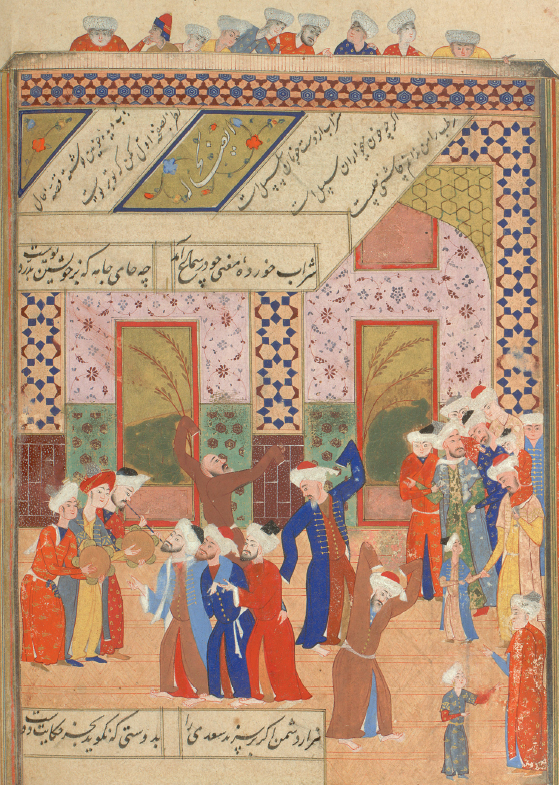Understanding World Societies:
Printed Page 258
Chapter Chronology
The Mystical Tradition of Sufism

Sufi Collective Ritual
Collective or group rituals, in which Sufis tried through ecstatic experiences to come closer to God, have always fascinated outsiders, including non-Sufi Muslims. Here the sixteenth-century Persian painter Sultan Muhammad illustrates the writing of the fourteenth-century lyric poet Hafiz. Notice the various musical instruments and the delicate floral patterns so characteristic of Persian art. (Or. Ms. 104, from The Kulliyyati-I Sa’di [ The Collected Works of Sa’di], 1556, vellum/Edinburgh University Library, Scotland/With kind permission of the University of Edinburgh/The Bridgeman Art Library)> PICTURING THE PASTANALYZING THE IMAGE: What sort of architectural space is depicted here? What distinctions do you see among the people in terms of how they dress and what they are doing?CONNECTIONS: How common are music and dance in religion? What do they provide?
Like the world’s other major religions — Buddhism, Hinduism, Judaism, and Christianity — Islam also developed a mystical tradition: Sufism (SOO-fih-zuhm). It arose in the ninth and tenth centuries as a popular reaction to the materialism and worldliness of the later Umayyad regime. Sufis sought a personal union with God — divine love and knowledge through intuition rather than through rational deduction and study of the shari’a. The earliest of the Sufis followed an ascetic routine (denial of physical desires to achieve a spiritual goal), dedicating themselves to fasting, prayer, meditation on the Qur’an, and the avoidance of sin.
The woman mystic Rabi’a (717–801) epitomized this combination of renunciation and devotion. An attractive woman who refused marriage so that nothing would distract her from a total commitment to God, Rabi’a attracted followers, for whom she served as a spiritual guide.
Between the tenth and the thirteenth centuries groups of Sufis gathered around prominent leaders called shaykhs; members of these groups were called dervishes. Dervishes entered hypnotic or ecstatic trances, either through the constant repetition of certain prayers or through physical exertions such as whirling or dancing.
Some Sufis acquired reputations as charismatic holy men to whom ordinary Muslims came seeking spiritual consolation, healing, charity, or political mediation between tribal and factional rivals. Other Sufis became known for their writings. Probably the most famous medieval Sufi was the Spanish mystic-philosopher Ibn al’Arabi (1165–1240). The author of a number of important works, he traveled widely in Spain, North Africa, and Arabia seeking masters of Sufism.
How did Islamic education compare to education in Europe and China?
